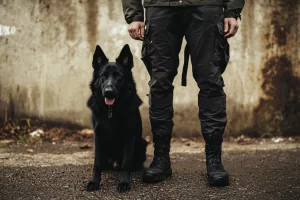German Shepherd Crate Training Tips
Crate training a German Shepherd can be challenging. This can be especially true when you have a new German Shepherd that might be crying and distressed in their new environment. Czech Working LIne has some tips to remember that “training” means helping your dog learn to be comfortable in their crate, and this process won’t be instant. Here are some valuable tips to help you prevent your German Shepherd puppy from crying while crate training.
First, understand that effective crate training takes time, and the pace can vary depending on the individual dog. Having a plan to confine your new puppy during the first few weeks is crucial, as some dogs might not be immediately crate trained. In fact, sometimes a new dog might seem fine in the crate because they’re scared, but once they get comfortable, they start crying and resisting confinement. This likely means that they were never really crate trained to begin with. Patience and rightful training from the start can solve this issue.
One common suggestion is to let the puppy cry it out, especially when it’s clear that they’re whining for attention. To do this correctly, make sure your puppy doesn’t need to go to the bathroom before crating them. If they’ve recently been outside and seem to be empty, you can ignore the whining. However, if you suspect they might need to go out, try to wait for a brief pause in the barking before letting them out. This teaches them that only calm behavior gets them out of the crate, not crying and barking. Very important in this process, don’t reward bad behavior. If your German Shepherd does not need to go potty, do not take your GSD puppy out of the crate.
That being said, there’s a key difference between demand barking and panicking. Some people might feel puppies can’t handle the confinement of a crate. This would rarely be the case, if you have obtained a well-bred puppy. The rare exception would be if you brought home an emotionally scarred rescue dog. This article is not addressing this situation. The focus of this article will solely be on normal, healthy German Shepherd puppies. While rescue dogs with emotional challenges may show signs of severe distress: nonstop barking, howling, drooling, panting, urinating, and even self-injury, these extreme forms of behavior would not be expected in a healthy puppy. For typical puppies, they will cry as they have been separated from their mother, but you would not expect nonstop barking, urinating or self-injury. With that said, during the first few days, there can be a lot of crying that might prompt you as the new pet owner to consider panting or urinating. Just saying…. it can be a trial.
One alternative is to use a puppy pen around the crate or attach it to the crate opening, leaving the crate door open or tied. Make the crate comfortable with bedding and entice your puppy to relax in it with favorite toys and treats. This set-up allows your puppy to adjust to the crate without feeling trapped. You can also place puppy pads on the pen floor initially, in case they need to relieve themselves, making it a secondary priority to teach them to love the crate first.
Some trainers will suggest placing your puppy in a small, secure room like a bathroom or utility room, using a baby gate instead of closing the door. Baby gates allow the puppy to feel less confined than a closed door and still keep them safe in a contained area. If you have access to a heated or cooled basement or garage, you can use a sturdy outdoor fence enclosure, offering more space while still providing a controlled environment. While this may be a short-term stop gap when you have a distressed puppy, don’t think of this transitional step as the end goal. Virtually all German Shepherd dogs will crate train and be happier for it. Be prepared for some crying and noise. If you have obtained a puppy with good genetics, one that comes from biddable lines (meaning easy to train), crate training shouldn’t be that painful after the first couple of days.
A training trick for particularly fearful puppies is to start with just the bottom part of a crate with the top off. Encourage your German Shepherd puppy to enter and get comfortable in the bottom half. Once they feel secure and willingly go into this space, you can reattach the top part of the crate with the door off and continue training. Gradually, reintroduce the door, rewarding your puppy with treats and praise every time they go in and stay calm.
If you find that after a few weeks of consistent training, your puppy still isn’t comfortable in the crate, consulting a Certified Professional Dog Trainer might be beneficial. They can offer personalized advice and help troubleshoot any specific issues you might be facing.
For long periods when you must leave the house, such as during workdays, some people will be tempted to consider alternatives like dog daycare. Daycare facilities allow your puppy to exercise, socialize with other dogs, and tire out, making them less likely to cry when confined later. Many daycare providers offer breaks throughout the day and help burn off excess energy, making crate or pen time more tolerable for your puppy. With that said, day care facilities will rarely be equipped to train your puppy. Be very cautious and slow to implement this option. Much better to find someone to to help with training pitfalls than to take your puppy to a day care center.
In addition to confinement strategies, it’s important to address food motivation issues. If your new puppy isn’t interested in treats, it might be due to stress. Dogs often lose their appetite when they don’t feel safe. Establishing a secure alternative confinement method and allowing your puppy some time to settle in can help alleviate this stress. Using high-value treats, like pieces of chicken, cheese, or hot dogs, can also be more enticing. Stress often impacts a dog’s willingness to eat, so giving them time to adjust and using more appealing treats can make a significant difference.
With a few weeks of solid training, proper planning, and patience, your German Shepherd puppy can begin to feel much better about staying in their crate. This period is crucial to developing a positive association with the crate and preventing distress. Methods like gradual introduction, creating a positive environment, establishing consistent routines, and finding suitable confinement alternatives during training can all contribute to a successful crate training experience. The main goal is to ensure your puppy sees the crate as a safe and comfortable space rather than a place of isolation and fear.
By understanding and addressing your German Shepherd’s needs, you can foster a sense of security and trust that makes crate training a smooth and stress-free process. The time invested in proper training lays the foundation for a happy, well-adjusted, and obedient German Shepherd.




